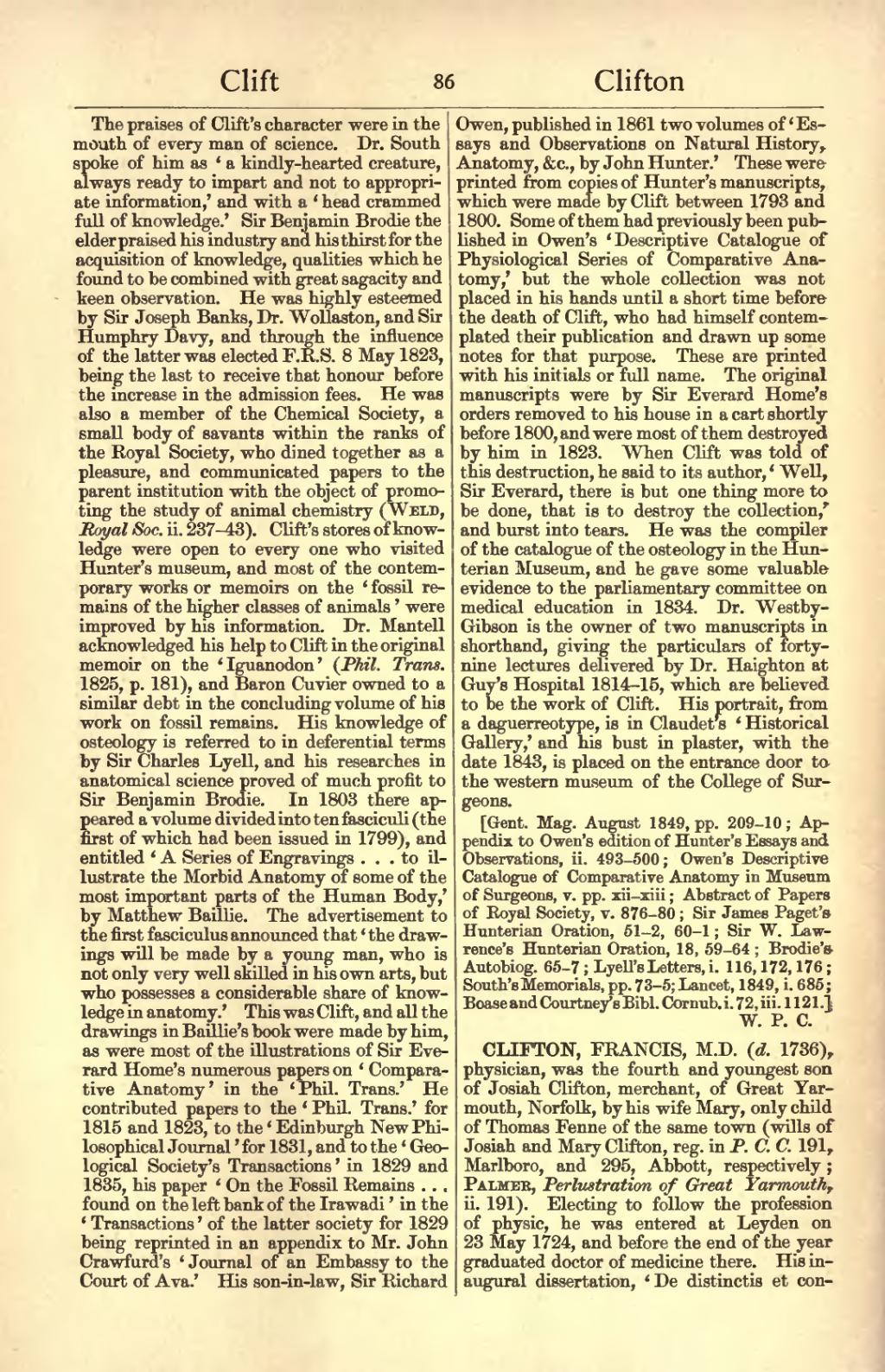The praises of Clift 's character were in the mouth of every man of science. Dr. South spoke of him as 'a kindly-hearted creature, always ready to impart and not to appropriate information,' and with a 'head crammed full of knowledge.' Sir Benjamin Brodie the elder praised his industry and his thirst for the acquisition of knowledge, qualities which he found to he combined with great sagacity and keen observation. He was highly esteemed by Sir Joseph Banks, Dr. Wollaston, and Sir Humphry Davy, and through the influence of the latter was elected F.R.S. 8 May 1823, being the last to receive that honour before the increase in the admission fees. He was also a member of the Chemical Society, a small body of savants within the ranks of the Royal Society, who dined together as a pleasure, and communicated papers to the parent institution with the object of promoting the study of animal chemistry (Weld, Royal Soc. ii. 237-43). Cliffs stores of knowledge were open to every one who visited Hunter's museum, and most of the contemporary works or memoirs on the 'fossil remains of the higher classes of animals' were improved by his information. Dr. Mantell acknowledged his help to Clift in the original memoir on the 'Iguanodon' (Phil. Trans. 1825, p. 181), and Baron Cuvier owned to a similar debt in the concluding volume of his work on fossil remains. His knowledge of osteology is referred to in deferential terms by Sir Charles Lyell, and his researches in anatomical science proved of much profit to Sir Benjamin Brodie. In 1803 there appeared a volume divided into ten fasciculi (the first of which had been issued in 1799), and entitled 'A Series of Engravings … to illustrate the Morbid Anatomy of some of the most important parts of the Human Body,' by Matthew Baillie. The advertisement to the first fasciculus announced that 'the drawings will be made by a young man, who is not only very well skilled in his own arts, but who possesses a considerable share of knowledge in anatomy.' This was Clift, and all the drawings in Baillie's book were made by him, as were most of the illustrations of Sir Everard Home's numerous papers on 'Comparative Anatomy ' in the 'Phil. Trans.' He contributed papers to the 'Phil. Trans.' for 1815 and 1823, to the 'Edinburgh New Philosophical Journal' for 1831, and to the 'Geological Society's Transactions' in 1829 and 1835, his paper 'On the Fossil Remains … found on the left bank of the Irawadi' in the 'Transactions' of the latter society for 1829 being reprinted in an appendix to Mr. John Crawford's 'Journal of an Embassy to the Court of Ava.' His son-in-law, Sir Richard Owen, published in 1861 two volumes of 'Essays and Observations on Natural History, Anatomy, &c., by John Hunter.' These were printed from copies of Hunter's manuscripts, which were made by Clift between 1793 and 1800. Some of them had previously been published in Owen's 'Descriptive Catalogue of Physiological Series of Comparative Anatomy,' but the whole collection was not placed in his hands until a short time before the death of Clift, who had himself contemplated their publication and drawn up some notes for that purpose. These are printed with his initials or full name. The original manuscripts were by Sir Everard Home's orders removed to his house in a cart shortly before 1800, and were most of them destroyed by him in 1823. When Clift was told of this destruction, he said to its author, 'Well, Sir Everard, there is but one thing more to be done, that is to destroy the collection,' and burst into tears. He was the compiler of the catalogue of the osteology in the Hunterian Museum, and he gave some valuable evidence to the parliamentary committee on medical education in 1834. Dr. Westby-Gibson is the owner of two manuscripts in shorthand, giving the particulars of forty-nine lectures delivered by Dr. Haighton at Guy's Hospital 1814-15, which are believed to be the work of Clift. His portrait, from a daguerreotype, is in Claudet s 'Historical Gallery,' and his bust in plaster, with the date 1843, is placed on the entrance door to the western museum of the College of Surgeons.
[Gent. Mag. August 1849, pp. 209-10; Appendix to Owen's edition of Hunter's Essays and Observations, ii. 493-500; Owen's Descriptive Catalogue of Comparative Anatomy in Museum of Surgeons, v. pp. xii-xiii; Abstract of Papers of Royal Society, v. 876-80; Sir James Paget's Hunterian Oration, 51-2, 60-1; Sir W. Lawrence's Hunterian Oration, 18, 59-64; Brodie'a Autobiog. 65-7; Lyell's Letters, i. 116, 172, 176; South's Memorials, pp. 73-5; Lancet, 1849, i. 685; Boase and Courtney's Bibl. Cornub. i. 72, iii. ll21.]
CLIFTON, FRANCIS, M.D. (d. 1736), physician, was the fourth and youngest son of Josiah Clifton, merchant, of Great Yarmouth, Norfolk, by his wife Mary, only child of Thomas Fenne of the same town (wills of Josiah and Mary Clifton, reg. in P. C. C. 191, Marlboro, and 295, Abbott, respectively; Palmer, Perlustration of Great Yarmouth, ii. 191). Electing to follow the profession of physic, he was entered at Leyden on 23 May 1724, and before the end of the year graduated doctor of medicine there. His inaugural dissertation, 'De distinctis et con-

